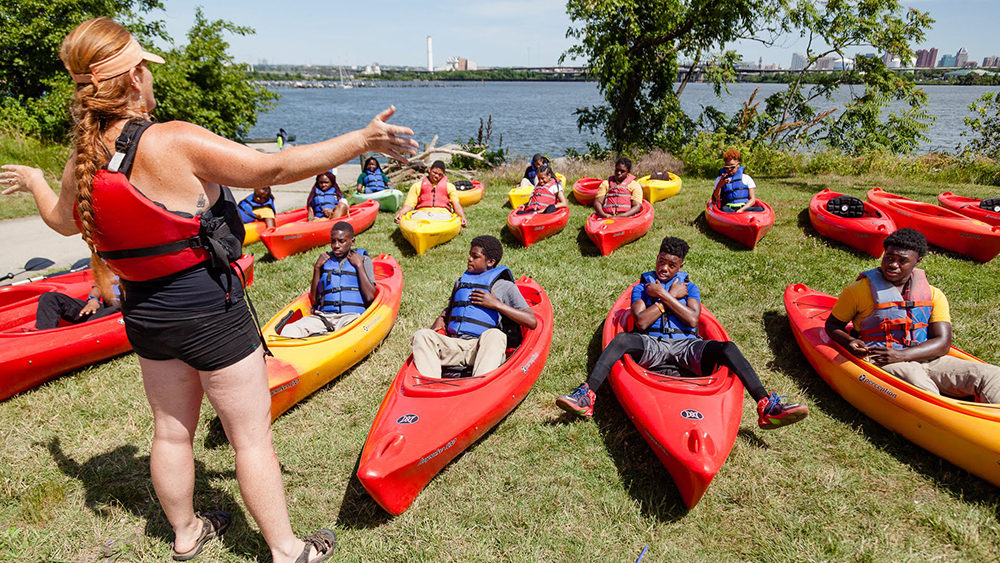Travel & Outdoors
Cameo: Molly Gallant
We talk to the outdoor recreation programmer for Baltimore City Recreation & Parks.
Thanks to its location between the mountains and the bay, Baltimore has a surprising number of outdoor offerings, doesn’t it?
We have 4,600 acres of parkland. We have three major trail systems—bike and pedestrian—going through West, Central, and East Baltimore—four, if you include the harbor promenade. The water is a completely and totally under-utilized resource in Baltimore. We have miles and miles and miles of waterfront, and tons of publicly owned waterfront parks. There are just so many resources and a lot of people don’t realize they’re here.
Why are so many of these outdoor opportunities still unknown?
Outdoor recreation has traditionally been something that has been passed down generationally. You had somebody in your family or very close to you that was a fisherman or boater, but as people moved away from those types of activities, they stopped being passed down.
There’s also this other phenomenon called the “bro-ification” of the outdoors. Whether its mountain biking or climbing, outdoor recreationists have traditionally been white affluent males. Now, there are more single female heads of household, so you have to make sure women have access to these skills, too.
The other big one is [access to] equipment. Recreation & Parks owns a fleet of bikes for getting people out on the trails, we own a fleet of kayaks for use, and we have an excellent staff of trained instructors.
With Baltimore City Recreation & Parks, you’re tasked with running a medley of outdoor programs throughout the city. Why is it so important to educate people on the environment?
If you don’t have people connected to these natural resources, they don’t seem to be interested in them. You’re not going to care about the rivers and the streams in Baltimore unless you start spending time on them. You can lecture people about the urban issues in watersheds and stream valleys, but you take them there, and you have them fall in love with fishing or kayaking, and it means something very different. I think Baltimore has a really unique opportunity to provide that.
At what point did you realize this was what you wanted to do?
I have known since I was a small child that I needed to stay outside. I grew up on a horse farm in Baltimore County, almost somewhat feral. For me, escaping into the streams and woods and running along the trails was like my entire existence. It didn’t matter what the weather was—snow, rain—you had to drag me inside. I went to environmental high schools. I went to a college for adventure sports. I’ve always had outdoor jobs, like ski resorts, Living Classrooms Foundation, and Outward Bound.
With Baltimore, it really hit home when I first moved back. I was having a hard time being in the city because I needed that green space. I needed to be outside, and all of sudden, I felt like I was surrounded by concrete and it was because I did not know about the park system. Once I learned about what was going on here and how to use it, I started sharing it with other people as much as I possible.
What is your biggest goal with these programs?
I want to work myself out of a job. At the end of the day, I want to make sure we have given everyone such a good foundation that you don’t need me anymore. You don’t need me to go for a hike or a bike ride, because you have enough confidence and skill that you went out and bought your own. Everyone should have their own bike. Everybody should have their own kayak. Everybody should find whatever their passion is and be able to do it here in Baltimore.
What is your favorite program?
The sunset paddle. Sometimes you get “wow” sunsets that are just unbelievable. There’s this capstone of sitting around, floating in the middle of Baltimore City, but it’s so quiet because you’re on the water and watching the sky light up in all of these crazy colors. And every once in awhile, because we’re down near M&T Bank Stadium, the next thing you know, you look over and it has erupted in purple fireworks. It’s like a fireworks display just for us.
What is the most rewarding part of your job?
In the wintertime, I do a lot of my planning and office work and meetings. It’s really tough to be part of a city agency advocating for something that’s a somewhat new concept in an urban area. Sometimes the bureaucracy of it all is really challenging. But when you get to have an 8-year-old in your canoe for an afternoon paddle, and they’re looking at you, telling you it looks like there’s a thousand stars in the water because they had never really seen sunlight glistening on the waves before, it melts you to the point where it makes all that frustration of trying to explain to people what you do, and why it’s important, worth it.
